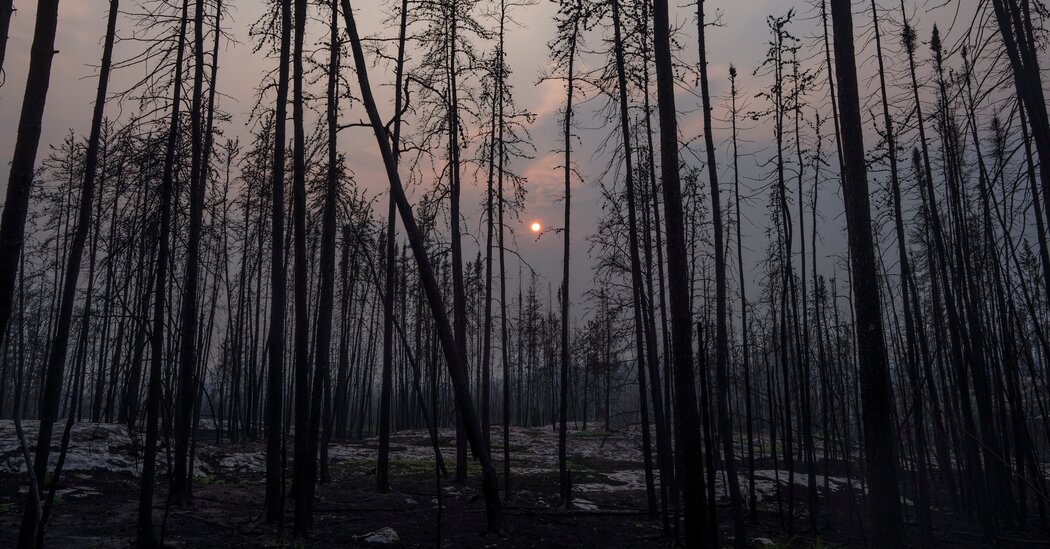Despite major progress in protecting vast tracts of rainforest, the world failed again last year to significantly slow the pace of global forest destruction, according to a report issued on Thursday. Record wildfires in Canada and expanding agriculture elsewhere offset big gains in forest protection in Brazil and Colombia, the report found.
The annual survey by the World Resources Institute, a research organization, found that the world lost 9.1 million acres of primary tropical forest in 2023, equivalent to an area almost the size of Switzerland, about 9 percent less than the year before. But the improvement failed to put the world on course to halt all forest loss by 2030, a commitment made by 145 nations at a global climate talks in Glasgow in 2021 and reaffirmed by all countries last year.
“Global leaders sent an undeniable message that forests are critical to meeting global climate goals,” said Rod Taylor, the global director for forests at the World Resources Institute. But, he added, “we are far off track and trending in the wrong direction.”
The immense wildfires in Canada last year destroyed such a huge tract of boreal forests, almost three times as much as in any other year, that they turned what would have been a 4 percent decrease in global forest loss into a 24 percent increase over last year.
The report focuses on the tropics because deforestation and fires there are mostly caused by human activity and can create longer-lasting consequences. The humid forests of tropical countries hold a quarter of all carbon stored on land and are home to a large share of animal and plant species, making their protection essential both to curb climate change and to avert biodiversity loss.
Researchers at the World Resources Institute, working in collaboration with the University of Maryland, documented tree loss across the world from deforestation, fires and other causes. Last year’s destruction resulted in 2.4 gigatons of carbon dioxide emissions, which is roughly equivalent to half of what the burning of fossil fuels in the United States produces each year.
Still, last year’s results showed that progress is possible when forest protection becomes a priority for world leaders. A recent change in leadership in Brazil and Colombia, which together hold almost a third of the world’s tropical forests, produced a steep decrease in deforestation rates in the two countries.
Brazil lost 2.8 million acres of forest last year, 36 percent less than in 2022. Ahead of taking office in 2023, President Luiz Inácio Lula da Silva took office said the country was “ready to resume its leading role in the fight against the climate crisis.” Brazil, which is home to more than half of the Amazon rainforest, accounted for 30 percent of the tropical forest loss globally last year.
Colombia, where President Gustavo Petro took office in 2022 vowing to protect the rainforest, recorded an even steeper improvement, slashing deforestation rates by 49 percent. Both Brazil and Colombia increased funding for environmental protection, created new programs to develop sustainable economic alternatives for rainforest regions and made efforts to protect local communities who defend forests.
But there are concerns about how permanent those gains will be. In Indonesia, one of the countries that has made the most progress in fighting deforestation over the past decade, tree loss has started ticking up again in the last two years.
“Ephemeral victories or ephemeral progress in slowing deforestation may not be progress at all,” said Matthew Hansen, the co-director of a laboratory at the University of Maryland that investigates changes in land use around the world.
But even the gains that researchers documented last year were largely offset by the expansion of agribusiness into tropical ecosystems around the world. The World Resources Institute researchers linked rising deforestation in Bolivia and Laos to the expansion of farms with the goal of increasing exports.
Forest loss in the Congo River Basin, the second-largest tropical forest area in the world, remained persistent last year, as economic hardship continued to drive communities to convert trees into firewood and charcoal for cooking.
Last year, man-made climate change fueled the record-breaking wildfires in Canada and seemed to leave its fingerprints around the world.
In Bolivia, blazes are also growing larger and burning the same areas repeatedly. It’s too early to say whether they were fueled by climate change. But the phenomenon has raised questions about whether some heavily degraded areas of the Amazon are transforming into different ecosystems, which some researchers worry could lead to a gradual forest-wide collapse.
Still, there is a lot governments, companies and communities can do to combat forest loss, beyond curbing the carbon emissions that cause climate change, said Mr. Taylor, the World Resources Institute director. New regulations and subsidies for forest protection could help, he said.
Unfortunately, these initiatives aren’t happening globally at a significant scale, Mr. Taylor said, “and that’s why we still see deforestation rates persisting.”


